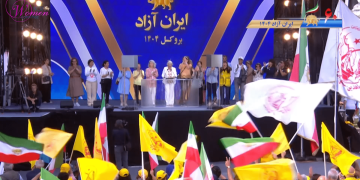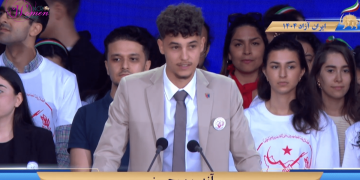This year, we are marking April 7, the World Health Day, as the coronavirus is sweeping across the globe. The World Health Organization has rightly announced April 7, 2020 as the day to celebrate the work of nurses and midwives, reminding the world of their critical role in keeping the world healthy.
The coronavirus outbreak is a global crisis and virtually all countries are having a difficult time in coping with the pandemic.
In Iran, however, the situation is quite different from other countries.
Even before the coronavirus outbreak, Iran stood way below the international standards with a severe shortage of physicians, nurses, and medical staff. With the outbreak turning into a crisis, Iran’s doctors and nurses as well as other medical staff have come under extraordinary pressure.

Shortage of nurses under normal conditions
Some 80% of nurses in Iran are women. Iranian nurses have always worked under tremendous stress. The outbreak has only worsened the already abysmal conditions of the work of nurses in Iran.
Prior to the coronavirus crisis, the country was short of some 150 to 240 thousand nurses.
At least 21 nurses died in Iran in the span of 2016 to 2018 due to stress at work because they are forced to work double shifts and do overtime work due to shortage of nurses.
In most European countries there are ten nurses per thousand. The global average is six nurses per thousand patients. In Iran, the ratio is one and a half nurses per thousand patients.
A nurse working at the Hospital of Qazvin says, “The medical staff are exhausted … One of our colleagues tested positive yesterday. We are getting sick one after the other and going out of work, leaving the burden of work on others. We may again have a very severe peak. This is serious. All beds have been full since the day I came here; I mean there has never been any vacancy.”
Javad Tavakoli, a member of the Nursing Board of Directors in Mashhad, said, “Nurses in some hospitals lack the full range of protective equipment, such as a gauze, N 95 masks, gloves and disinfectants.”
He added, “Nurses have been practically taken aback by the coronavirus crisis and have had to fill in the shifts according to the same work schedules that are available in a normal workplace, which is also 12 and 18 hours. So many of them are worn out and tired.” (The state-run Young Journalists Club website – March 6, 2020)
Presently, Iranian hospitals are stretched to the limit, and all nurses and physicians are exhausted. Mustafa Moin, head of the Supreme Council of the Medical System, wrote to the mullahs’ President, Hassan Rouhani: “Fatigue and the physical and mental toll on the medical staff will threaten the quality of treatment for patients.”

Nurses are underpaid and unpaid for months
At the frontline of the coronavirus pandemic are nurses and other healthcare workers who are working around the clock and putting themselves at risk to care for patients. Their workload is very demanding, yet their profession is one of the most undervalued, and under-paid jobs in Iran.
The salary of a nurse in formal employment with all perks is 3.3 million tomans a month ($220). But most nurses earn around 2 million tomans a month ($133), and many work for as low as 500,000 tomans ($33) without even having health insurance.
It is the policy of the regime to hire employees including nurses on temporary three-month contracts to avoid paying them insurance and other benefits.
It often happens that nurses do not receive their salaries for months and even up to a year.
Mohammad Mirza Beigi, head of the Nurses Organization, admitted that the delay in payment of salaries of nurses ranges from 8 to 22 months. (The state-run Arman Melli website – January 2, 2020)
More recently, the state media reported on the work of nurses and staff at medical universities who are facing delays in their payments for about 8 to 14 months! (The state-run Salamat News website – March 14, 2020)

Shortage of personal protective equipment
But shortage of personal protective equipment is adding insult to injury putting the lives of nurses and healthcare workers at risk of contracting the disease.
A nurse at the Razi Hospital of Rasht complains, “Unfortunately, we have very little equipment. The gown I’m wearing is not adequate, at all. In every shift, I must give a new mask to my patient. I must give a mask and gloves to his companion. Unfortunately, gowns and personal protective equipment are very scarce.”
Many of them are unable to change their protective gowns, because of their scarcity and poor quality. So, they have to keep working for long hours without being able to eat or drink or even using the bathroom because they cannot take off their gowns.
The Fox News broadcast conversations with a nurse in Iran who said, “We are using our own equipment for the patients. There is nothing else we could do. Whatever we have we use for the patients. We cannot do anything where there is no protective equipment. We must work without protective equipment and do the relocation of patients without protective gowns.” (The Fox News, March 28, 2020)
A report from Khoy on March 30 stated, “There is not a simple surgical mask for nurses in the hospital in Khoy. Nurses have to go to pharmacies to buy masks and protective equipment.”
Fatalities among nurses, physicians and the medical staff
An Iranian health expert says, “The highest number of coronavirus infections among government employees is related to doctors and nurses, indicating that the medical and nursing staff are among the most dangerous, difficult and harmful occupations.” (The state-run Salamat News website – March 14, 2020)
The deadly coronavirus has taken the lives of many dedicated doctors and nurses in the face of a lack of protective equipment for medical staff in Iran.
In a report in mid-March to the World Health Organization, the medical community supporting the Iranian Resistance pointed out that at least 100 physicians, nurses and medical staff had lost their lives to the coronavirus.
Mohammadreza Zafarghandi, head of the Medical Council, reported to the state-run daily newspaper, Hamshahri, “Thus far, about 170 doctors and nurses in Qom have been infected with COVID-19, and 37 doctors and nurses have died.”
Abdulreza Fazel, president of the Medical Sciences University of Golestan Province in Gorgan, was cited as saying, “Since mid-February, some 350 of the medical staff of Golestan Province have contracted respiratory diseases suspected of COVID-19.” (The state-run Tasnim news agency, March 28, 2020)
On the high mortality among nurses in Iran, Mohammad Sharifi Moghaddam, Secretary General of the Nurses Home, acknowledged, “Necessary measures are not taken to maintain the health of nurses. From the shortage of masks, gloves, scrubs and other equipment to the shortage of nursing staff that has forced nurses to care for more coronavirus patients in hospitals.” (The state-run Salamat News website – March 18, 2020)
Following are the names of some of the female nurses and medical staff who died of coronavirus:
Narjes Khan Alizadeh, 25, Lahijan; Fariba Izadpanah, Shiraz; Mowloud Jafari, Tehran; Nahid Noshad, Rasht; Azemat Moussavi, Sari; Firouzeh Khoshgoftar, Fouman; Anousheh Beikian, Tehran; Razieh Hosseinizadeh, Babol; Hanieh Edalati, Takestan; Tahmineh Adibi, Bandar Anzali; Tahereh Esmaili, Qom
It was reported on Friday, March 27, 2020, that two unidentified nurses in Astara, Gilan Province, died of coronavirus.
Also, Dr. Niloufar Esmail Beigi, a general physician in Tehran, and Dr. Shirin Rohani-Rad, a physician in Pakdasht are among the physicians who lost their lives in the global combat against the coronavirus.
Cover-up and mismanagement contribute to rapid spread of the virus
By covering up the scale of the outbreak and disseminating false information, refusing to take pre-emptive measures and distributing medical equipment, and failing to halt travel to China and abroad, the mullahs’ regime in Iran had an adverse impact resulting in a dramatic increase in the number of the victims across the country and in the spread of the virus even to other countries in the region and around the world.
One of the regime officials recently confirmed the above.
Mustafa Moin, head of the Supreme Council of the Medical System and former Minister of Science, Research and Technology, stated, “The government’s actions have been neither successful nor defensible. There has been a lack of alerts or predictions; there was the failure to suspend Mahan Air flights to China and the delay in acknowledging the Coronavirus outbreak. There has been a lack of transparency, or a cover-up, about this outbreak, including repeated unscientific or contradictory statements by state and health officials. There has been a failure to make firm or timely decisions regarding quarantine in the city of Qom. There has been a long delay in implementing both social distancing and restrictions on transportation and inter-city travel. The lack of basic safety facilities and protections for doctors, nurses, and other medical staff has led to the loss of the best and most specialized medical personnel, as well as numerous patients. [Iran’s medical community] is not on par with global standards, and the lack of masks, gloves, and disinfectants on the national level are examples of that inefficiency.”
The Iranian Resistance has also disclosed documents from inside the clerical regime and the National Emergency Organization showing that the regime was aware of the spread of the virus to Iran as early as January 24, 2020. But in order to mobilize crowds for the 1979 revolution anniversary on February 11 and the sham election on February 21, they brazenly denied the outbreak in the country.
Dr. Adham Ismail, WHO’s representative in Iraq, told the state-run Al-Iraqiya TV, on March 30, “If Iran had not been infected with the Coronavirus, we in Iraq would not have had such a hard time…. Iran has transmitted the epidemic to 17 countries. If Iran had played no part in this crisis, there would not have been an outbreak in Iraq given the measures we had taken…There have been clear breaches in regulations related to commuting to Iran.”
As of April 6, 2020, the Iranian Resistance announced the Coronavirus death toll had shockingly risen to 19,500 in 242 cities across Iran. If it were not for the work of nurses and other dedicated medical staff and physicians, the situation would have been worse in the face of the Iranian government inaction.
























